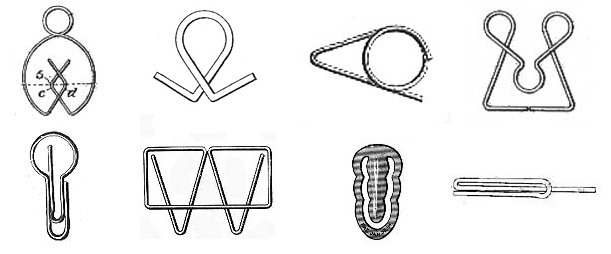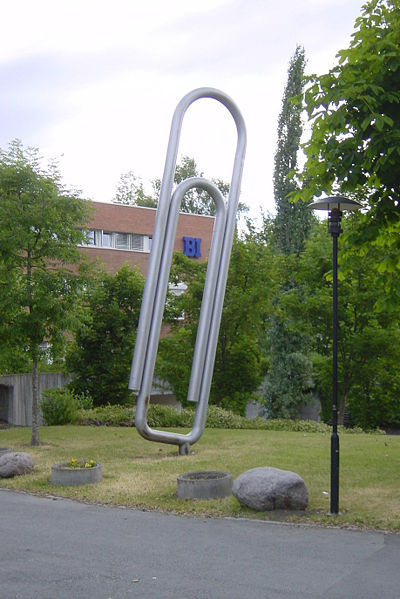I bought these paperclips yesterday and was surprised by the label. I was not surprised, however, when I googled "paperclip & trombone" and found that the always interesting Today I Found Out (author of The Wise Book of Whys*) blog had posted a well-researched answer to my question long before I thought to ask it. Excerpts below, but read the whole thing:
The word trombone originally comes from the Italian “tromba”, which comes from the same Latin word, “tromba”, both retaining the same meaning: trumpet. In this case, the ending with the added “one” (tromb-one), indicates “large”. So, essentially, trombone means “large trumpet”. This has been the name of the instrument in Italy likely since its creation, which is probably around the early 15th century.
“Clip”, on the other hand, comes from the Old English “clyppan” meaning: to embrace. Obviously this, combined with “paper” from the Latin “papyrus” (made from papyrus stalks), gave birth to the word paperclip.
Interestingly, the common style of paperclip today was never patented and is known as the “Gem paperclip”. Not surprisingly, it is thought to have first been manufactured by the Gem Manufacturing Company around the 1870s and later introduced to the United States around the 1890s. This is also why the Swedish word for paperclip is “gem”.
Undeserved patents and false origin stories:
 |
| Vaaler's design |
One very popular false origin of the paperclip was that it was invented by Norwegian patent office manager, Johan Vaaler. He was even granted patents in Germany and the U.S. for a paperclip of similar design as the Gem style paperclip, but which came after the Gem paperclip was already popular throughout Europe. His design was slightly different than the Gem paperclip in that it didn’t include the all too critical second loop that makes the Gem style much more functional. His paperclip had the papers inserted by lifting the outer wire slightly and pushing the papers into the clip such that the rest of the clip stood out from the paper at a 90 degree angle, which was necessary because of the lack of the critical second loop to allow the papers to be more or less embedded in the clip flatly. This also made it so the papers wouldn’t be held together very well as they relied only on how bendable the wire used was to hold the papers. The Gem style paperclip, on the other hand, exploits the torsion principle to help bind papers together. Vaaler’s design was never manufactured or sold and his patents eventually expired.
 |
| Alternative designs |
Why Vaaler gets the credit in so many places, including in many encyclopedias and dictionaries after the 1950s, is largely thanks to a patent agency worker who was visiting Germany to register Norwegian patents in the 1920s. When he was doing so, he noticed Vaaler’s design for the paperclip and wrote an article stating Vaaler was the original creator of the paperclip.
This misinformation found its way into encyclopedias around the 1950s thanks to WWII. During WWII in Norway particularly, along with France and some other occupied countries, the paperclip became a symbol of unity for those rebelling against the Germans. It is not thought that the Norwegians did this because they thought a Norwegian had invented the paperclip, but rather because it simply signified being bound together and was useful as it wasn’t initially a banned symbol or item by the Germans and could be easily clipped to one’s clothing. Eventually, the Germans caught on and people were prohibited from wearing paperclips.
After the war, the fact that the Gem style paperclip had served as a symbol of unity resulted in interest in the origin of the paperclip, at which point the article written by the patent agency worker and the subsequent patent by Vaaler, who was now long dead, was discovered. It was overlooked, of course, that his design was different than the Gem style paperclip and apparently they didn’t bother checking that the Gem style paperclip had already been around by the time Vaaler patented his version of the paperclip. It made a good story though, particularly after the war and how the paperclip was used in Norway among other places, and so this false origin subsequently found its way into many encyclopedias.
The same site has more on the paperclip as a symbol of resistance here.
The Wise Book of Whys is a favorite of mine when it comes to gift-giving - several of my grandchildren have received a copy.


No comments:
Post a Comment